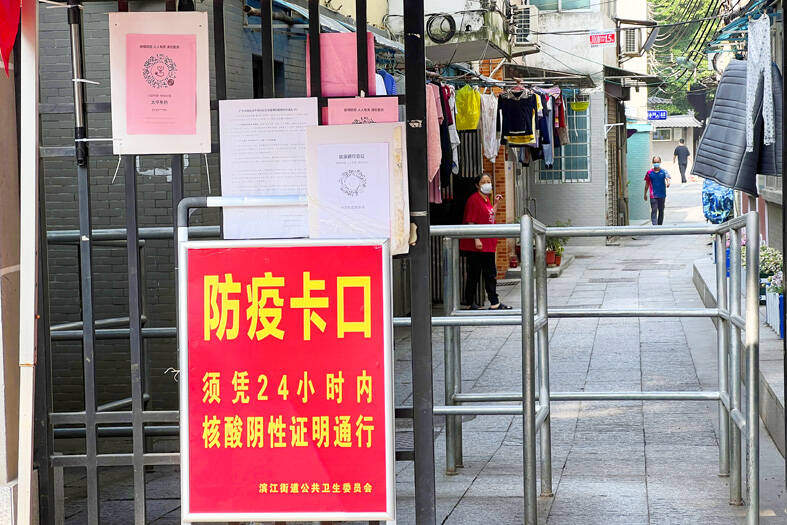China’s tough COVID-19 lockdowns are fueling an increase in public anger, with some residents in Guangzhou, one of the country’s biggest cities, staging rare protests against the stringent rules.
In videos circulating on social media, hundreds of protesters were seen marching in the street and pushing over police barriers in Haizhu district, which has been in lockdown since late last month.
The demonstrations took place in several “urban villages,” mainly poorer neighborhoods where migrant workers live, the Hong Kong Economic Journal reported.

Photo: AP
The local government sent multiple police vehicles to the protests, the paper said.
Chinese residents are becoming increasingly upset after almost three years of draconian social restrictions under the country’s “zero COVID-19” policy.
Lockdowns are showing no sign of abating even as authorities ease some curbs, such as shortening the mandatory quarantine period for inbound travelers and scrapping a system where airlines are penalized for carrying infected passengers.
Food shortages and difficulty getting timely medical treatment are some of the biggest complaints lodged by those shut into their homes.
Few posts discussing the protests — deemed riots by some — could be found on Sina Weibo and WeChat, two of the largest social media platforms in China, where online discussions are censored to control public opinion.
As of yesterday morning, hashtags on Weibo such as “Guangzhou Haizhu district riot” and “Haizhu riot” remained visible, but posts which could previously be seen were gone.
Guangzhou has locked down two other districts, including Panyu and Liwan, as daily infections surged to 5,124 on Monday.
Huang Kunming (黃坤明), the Chinese Communist Party chief of Guangdong, the province that includes Guangzhou, ordered officials to eliminate the virus in communities “as soon as possible,” the paper reported, citing an internal meeting on Monday evening.

Asian perspectives of the US have shifted from a country once perceived as a force of “moral legitimacy” to something akin to “a landlord seeking rent,” Singaporean Minister for Defence Ng Eng Hen (黃永宏) said on the sidelines of an international security meeting. Ng said in a round-table discussion at the Munich Security Conference in Germany that assumptions undertaken in the years after the end of World War II have fundamentally changed. One example is that from the time of former US president John F. Kennedy’s inaugural address more than 60 years ago, the image of the US was of a country

Cook Islands officials yesterday said they had discussed seabed minerals research with China as the small Pacific island mulls deep-sea mining of its waters. The self-governing country of 17,000 people — a former colony of close partner New Zealand — has licensed three companies to explore the seabed for nodules rich in metals such as nickel and cobalt, which are used in electric vehicle (EV) batteries. Despite issuing the five-year exploration licenses in 2022, the Cook Islands government said it would not decide whether to harvest the potato-sized nodules until it has assessed environmental and other impacts. Cook Islands Prime Minister Mark Brown

BLIND COST CUTTING: A DOGE push to lay off 2,000 energy department workers resulted in hundreds of staff at a nuclear security agency being fired — then ‘unfired’ US President Donald Trump’s administration has halted the firings of hundreds of federal employees who were tasked with working on the nation’s nuclear weapons programs, in an about-face that has left workers confused and experts cautioning that the Department of Government Efficiency’s (DOGE’s) blind cost cutting would put communities at risk. Three US officials who spoke to The Associated Press said up to 350 employees at the National Nuclear Security Administration (NNSA) were abruptly laid off late on Thursday, with some losing access to e-mail before they’d learned they were fired, only to try to enter their offices on Friday morning

STEADFAST DART: The six-week exercise, which involves about 10,000 troops from nine nations, focuses on rapid deployment scenarios and multidomain operations NATO is testing its ability to rapidly deploy across eastern Europe — without direct US assistance — as Washington shifts its approach toward European defense and the war in Ukraine. The six-week Steadfast Dart 2025 exercises across Bulgaria, Romania and Greece are taking place as Russia’s invasion of Ukraine approaches the three-year mark. They involve about 10,000 troops from nine nations and represent the largest NATO operation planned this year. The US absence from the exercises comes as European nations scramble to build greater military self-sufficiency over their concerns about the commitment of US President Donald Trump’s administration to common defense and